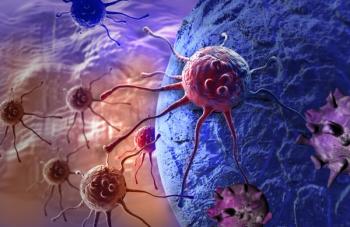
- ONCOLOGY Nurse Edition Vol 23 No 4
- Volume 23
- Issue 4
An Alkylating Agent for CLL and NHL
Bendamustine HCl for injection is FDA approved for treatment of patients with chronic lymphocytic leukemia (CLL) or indolent B-cell non-Hodgkin’s lymphoma (NHL) that has progressed during or within 6 months of treatment with rituximab (Rituxan) or a rituximab-containing regimen.
Approved Drug
Bendamustine HCl for Injection (Treanda)
Indications
Bendamustine HCl for injection is FDA approved for treatment of patients with chronic lymphocytic leukemia (CLL) or indolent B-cell non-Hodgkin’s lymphoma (NHL) that has progressed during or within 6 months of treatment with rituximab (Rituxan) or a rituximab-containing regimen.
Mechanism of Action
Bendamustine HCl is an alkylating agent that is derived from nitrogen mustard. It forms interstrand DNA crosslinks which lead to cell death in both resting and dividing cells. It also has purine-like structural groups that give the drug a unique mechanism of action.
Metabolism
Drug is 94%–96% bound to plasma proteins, and is primarily metabolized via hydrolysis to noncytotoxic metabolites. Two minor active metabolites are formed via CYP1A2. Bendamustine does not induce nor inhibit CYP metabolic pathways. Approximately 90% of the administered drug is recovered from the excreta, primarily feces.
Drug Preparation
• Aseptically inject 20 mL of Sterile Water for Injection, USP into the 100 mg bendamustine HCl for injection vial. Shake well; the powder should dissolve completely in 5 minutes. The resulting solution is pale yellow, with a concentration of 5 mg/mL. Do not use if there is particulate matter.
• Aseptically withdraw the ordered dose and transfer to a 500 mL 0.9% Sodium Chloride infusion bag (or alternatively, 2.5% Dextrose/0.45% Sodium Chloride, but no other solutions are compatible).
• Once further diluted, drug is stable for 24 hours refrigerated (2°C–8°C or 36°F–47°F), or 3 hours at room temperature (15°C–30°C or 59°F–86°F) and room light.
Drug Administration
• CLL: Bendamustine HCl at 100 mg/m2 is administered by IV infusion over 30 minutes on days 1 and 2 of a 28-day cycle, for up to six cycles. (Dose is delayed for grade 4 hematologic or grade 2 or higher nonhematologic
toxicity, and dose is modified for grade 3 or 4 toxicity.) • NHL: Bendamustine HCl at 120 mg/m2 is administered by IV infusion over 60 minutes on days 1 and 2 of a 21-day cycle, for up to eight cycles. (Dose is delayed for grade 4 hematologic or grade 2 or higher nonhematologic toxicity, and dose is modified for grade 4 hematologic or grade 3 nonhematologic toxicity.)
• Monitor patient closely during drug infusion for signs and symptoms of infusion reaction or anaphylaxis; stop drug, and treat symptomatically. If infusion reactions occur, give pretreatment with diphenhydramine in subsequent cycles.
Patient Education
• Drug will cause lowering of white blood cell count, with increased risk of infection; lowering of platelet count, with increased risk of bleeding; and lowering of red blood cell count, with increased risk of fatigue.
• Patient should report any signs and/or symptoms of infection (for example, shortness of breath, fever, burning on urination, productive cough) or bleeding right away.
• Patient must avoid contact with large crowds, very young children, and people who have colds, as this may expose patient to infection.
• Fatigue will occur, and self-care strategies should be used to minimize fatigue. Patient should not operate any dangerous tools or machinery if fatigued.
• Allergic reactions can occur, and the patient should report right away rash, facial swelling, or any difficulty in breathing during or soon after completion of the infusion.
• Drug can cause damage to the unborn fetus. Patient should use effective birth control measures during treatment and for 3 months after therapy has stopped (both men and women). Patients who think they are pregnant should inform their doctor or nurse right away.
• Mothers should not breastfeed their infants while receiving bendamustine.
• Patients should report immediately severe or worsening rash or itching.
Drug Interactions
• CYP1A2 inducers (eg, modafinil, insulin, omeprazole, smoking tobacco) may decrease bendamustine serum levels, and inhibitors (eg, cimetidine, ciprofloxacin, fluvoxamine) may increase bendamustine serum levels; avoid co-administration if possible.
Special Considerations
• Consider tumor lysis prevention with allopurinol during the first few weeks of treatment in patients at high risk for this complication.
• If skin reactions are severe or progressive, bendamustine HCl should be withheld or discontinued.
• Drug should be used cautiously in patients with mild hepatic or renal impairment.
• Patients from Japan may have a 40% increase in drug exposure.
• Drug is highly emetogenic and requires effective antiemetics prior to drug administration.
• Myelosuppression may be severe, requiring dose delay or reduction; monitor patient closely and restart treatment based on absolute neutrophil count (ANC) and platelet count.
• Monitor patient closely for signs and symptoms of infection, and treat promptly.
• Drug appears to have activity in tumor cell lines resistant to other alkylating drugs.
Contraindications/Precautions
• Patients with a known hypersensitivity to bendamustine or mannitol should not receive the drug.
• Drug should not be administered to patients with moderate or severe hepatic impairment.
• Drug should not be administered to patients with severe renal impairment (creatinine clearance < 40 mL/min)
Articles in this issue
over 16 years ago
ONCOLOGY Nurse Edition April 2009, Vol 23 No 4over 16 years ago
Hypertension Management in the Era of Targeted Therapies for Cancerover 16 years ago
Vesicant Extravasation From an Implanted Venous Access Portover 16 years ago
Survivorship Care: Essential Components and Models of Deliveryover 16 years ago
Cardiotoxicities of Breast Cancer Treatmentover 16 years ago
Improving the End-of-Life Experienceover 16 years ago
When Hospice Is the Best Option: An Opportunity to Redefine Goalsover 16 years ago
Living Well: A Goal for All Patientsover 16 years ago
The Patient With Cancer-Related DyspneaNewsletter
Stay up to date on recent advances in the multidisciplinary approach to cancer.

















































































